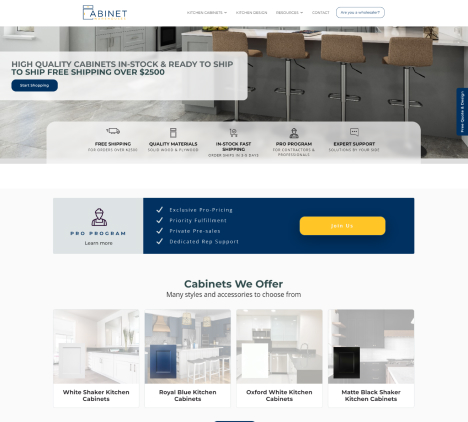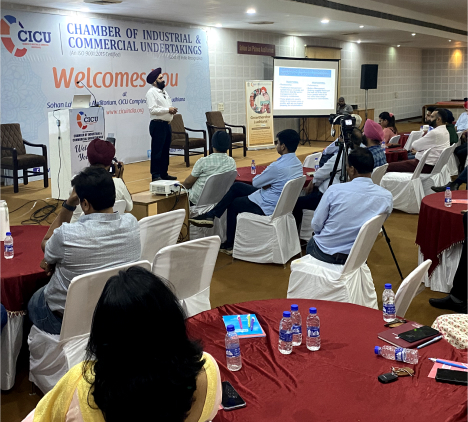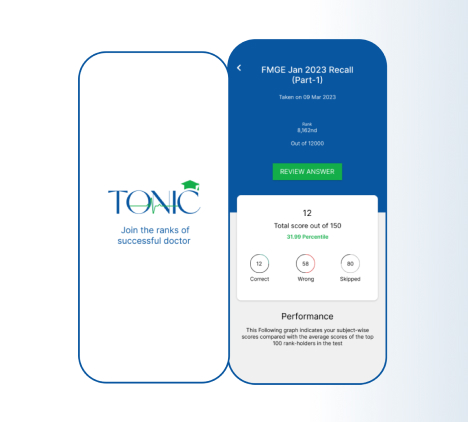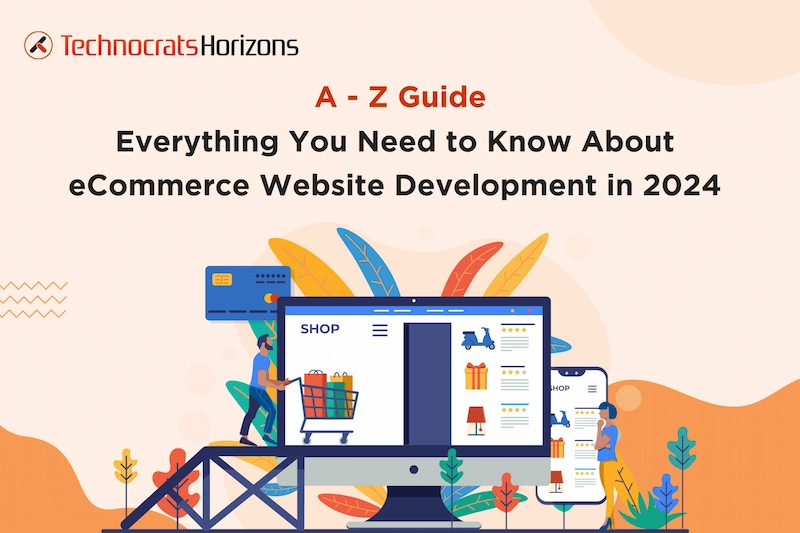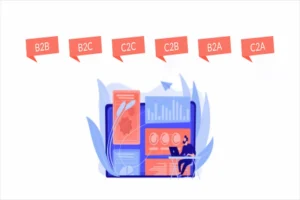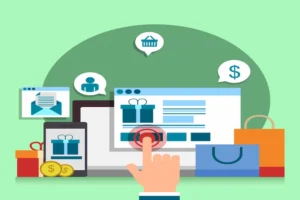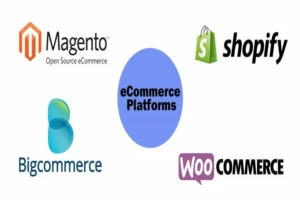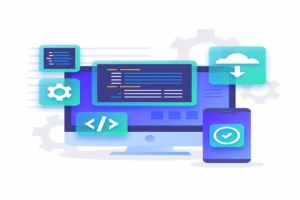Are you curious about what an eCommerce website is and why it’s crucial for modern businesses? Wondering about the essential elements and platforms to consider when developing one?
According to a recent Nasdaq report, 95% of purchases are expected to be completed online by 2040, highlighting the thriving trend of online shopping.
Even with the most incredible products, success in online business is unattainable without a well-designed and functional eCommerce website. To thrive in the online marketplace, your eCommerce site needs to be both visually appealing and efficient.
However, creating an eCommerce website can be challenging, especially for those unfamiliar with custom eCommerce software development. It involves conducting thorough market research, using the right technologies, and careful planning.
To assist you in this process, we’ve created a comprehensive guide on eCommerce website development. Our guide takes you through every stage, from initial planning to site launch and ongoing maintenance.
What is eCommerce Website Development?
eCommerce website development refers to the process of creating an online store where customers can make purchases. It involves implementing technical and strategic plans for the website’s shopping cart, product pages, help pages, and both front and back ends.
With eCommerce web development services, customers can select products, place orders, schedule deliveries, and make payments, all in one place, making it a comprehensive one-stop shop for your company.
It’s challenging to imagine modern lives without online shopping, emphasizing the solid foundation and significance of customized eCommerce development services. Social media accounts are now being used as eCommerce websites due to their flexible options and user-friendly processes.
For a detailed guide on eCommerce website development, continue reading the sections below.
Benefits of eCommerce Website Development
eCommerce website development comes with various advantages for businesses of all sizes. Here are some key benefits of eCommerce web development services:
1. Global Reach
An eCommerce website enables businesses to reach a broader audience beyond their local area. By utilizing such a platform, businesses can extend their customer base and increase revenue by offering products or services to consumers worldwide.
2. Increased Sales
eCommerce sales are projected to reach $8.1 trillion in 2026, so there’s a huge sales opportunity waiting for you.
eCommerce websites allow businesses to showcase and sell their products or services 24/7, without being constrained by traditional business hours. This capability to generate profit even when physically closed enhances the potential for increased sales.
3. Cost-effectiveness
Developing an eCommerce website is a cost-effective means for businesses to establish an online presence. With a well-designed eCommerce platform, businesses can present their products and services online without the need for a physical store, thereby reducing overhead costs.
4. Improved Customer Experience
eCommerce development services enhance the customer experience by simplifying and streamlining the purchasing process. Features like easy product search, a straightforward checkout process, and secure payment options contribute to quick and effortless transactions, ultimately boosting customer satisfaction.
5. Improved Brand Identity
Custom eCommerce software development provides businesses with the opportunity to build and strengthen their online brand identity. Utilizing customized branding and design that reflects a company’s objectives and core values helps create a distinctive online presence that is both memorable and unique.
6. Better Data Analysis
Customized eCommerce development services enable businesses to gain valuable insights into customers’ browsing and buying habits. Utilizing this data to refine product offerings and tailor marketing strategies can lead to increased sales and enhanced customer loyalty.
Types of eCommerce Business Models
You need to choose a business model before venturing into eCommerce. Who do you want to sell to? This is a major question you need to address. Here are the most prominent business models for eCommerce website development:
• Business-to-Business (B2B)
B2B eCommerce is expected to generate $18.57 trillion in revenue in 2026.
In B2B commerce, at least two organizations engage in trade. Manufacturers often control retailers and traditional wholesalers within the trade routes. So basically, one vendor sells to another vendor under this model.
• Business-to-Consumer (B2C)
Websites facilitating interactions between businesses and consumers are known as B2C websites. For example, when a customer purchases jeans from GAP, it is a B2C business model.
• Consumer-to-Business (C2B)
C2B eCommerce is the opposite of the traditional paradigm, where businesses purchase products or services directly from customers. Platforms like iStockPhoto allow users to buy stock photographs for their businesses.
• Customer-to-Customer (C2C)
C2C commerce involves customers selling their used goods and services to other customers online. Transactions are facilitated through platforms like Quikr, acting as a third party working with OLX.
• Business-to-Administration (B2A)
B2A facilitates transactions between e-businesses and public agencies, dealing with goods associated with social security, legal data, etc.
• Consumer-to-Administration (C2A)
C2A, similar to B2A, involves consumers selling goods and services to public administrative organizations. C2A websites offer online tax preparation, online education advice, and similar services.
Five Characteristics of a Successful eCommerce Website
An effective eCommerce website must incorporate key components that cover every aspect, from the checkout process to interactive sections.
1. Responsive Design
Excellent user interface (UI) and user experience (UX) are crucial for a successful eCommerce website. Key components include a search bar, clear copy, a clean design, and filters to simplify product location for customers.
2. Safety
Dealing with sensitive data like credit card numbers requires extreme caution. Adhering to PCI Compliance standards for payment acceptance is essential to avoid fines and maintain customer trust. Certain platforms provide a basic SSL certificate, but additional investment may be needed for enhanced security.
3. SEO (Search Engine Optimization)
43% of eCommerce traffic comes from Google’s organic search results.
SEO is vital to improving your site’s search engine ranking and product visibility, ultimately increasing sales or conversion rates. Utilize content tactics such as incorporating targeted keywords in product descriptions and website copy to achieve higher search result rankings compared to competitors.
4. Marketing Techniques
Develop an eCommerce marketing strategy early in the eCommerce website development process. Consider features like social sharing buttons or mobile app integration, aligning with your overall marketing goals. These decisions impact the required features and layout of your website.
5. Easy Checkout
A seamless checkout process is essential for preventing a decline in sales. Complex registration procedures may deter customers from completing purchases. Consider offering a “guest checkout” option to simplify transactions and enhance the overall user experience.
Ready to Boost Sales with an eCommerce Website? Reach Out Now!
Things to Consider Before eCommerce Website Development
No business should directly jump into eCommerce development services without actually considering all the factors related to it beforehand. We have listed a few key points below that you can keep in mind before going into eCommerce website development:
• Explore Your Business Sector in Detail
It’s important to conduct extensive research in your industry before venturing into the world of custom eCommerce website development services. This involves delving into the nuances and gaps in your company’s environment. Take the time to understand the trends, choices, and demographics of your target market. The development of product categories, descriptions, payment options, product images, and other crucial components will be guided by this understanding.
• Address Your Audience’s Needs
Once you have a firm grasp of what you have to offer, prioritize potential clients using sales intelligence. How can you achieve this? By becoming thoroughly familiar with their purchasing habits, demographics, geographic factors, and subtle cultural differences. Building an interactive feedback system allows you to directly collect feedback from customers and use that information to formulate customized responses that define your online business.
• Create an MVP (Minimum Viable Product)
Understand that the primary goal of an eCommerce store is to make sales, and the purpose of an eCommerce MVP is to gauge customer interest in the products and services being offered. Using an MVP is crucial if you aim for a creative eCommerce website development with a high conversion rate.
• Empower Your Team
To boost sales and business volume, you need a dedicated team of sales development representatives (SDRs). Before initiating custom eCommerce development services, ensure that your team possesses the necessary skills for a successful launch. Invest in enhancing the sales process and provide comprehensive team training to address potential issues with productivity and efficiency.
• Develop an eCommerce Spending Plan
Feeling the temptation to overspend is common, especially when your eCommerce business is just starting. It’s crucial to exercise caution, stick to your budget, and have plans in place to ensure financial responsibility. To navigate the financial landscape successfully, it’s a wise idea to regularly reassess your budget with each financial decision. Customized eCommerce web development services can be a bit on the expensive side so invest carefully.
Step-By-Step Guide on eCommerce Website Development Process
Custom eCommerce development is not an easy process and you need to follow a meticulous development process to meet the expectations of the business and its customers. When going through eCommerce website development, keep the following things in mind:
Step 1. Identify Your Target Market
Determining and understanding your target audience is a crucial first step in effective custom eCommerce website development. Remember, your website is the most vital platform for your company, where conversions take place. For eCommerce web design that resonates with your client’s specific wants and interests, you must first comprehend your clients.
Conducting audience research is probably the best approach to determining your target market. Audience research aims to create precise buyer personas through thorough research. Start with your client database as the initial point for research and examine recurring patterns. Review past purchases and average order value to determine the price range at which your target market is willing to buy your goods. All-in-all a good eCommerce website development begins with great research.
Step 2. Develop Your Brand Identity
Your ability to connect with a diverse audience is hindered by the absence of a clear brand identity. Look at successful organizations like Amazon, known for their unique logos, detailed product descriptions, user ratings, immersive product videos, captivating imagery, impactful messaging, and personalized wish lists. Create a distinctive logo, define your brand’s voice, and develop a well-thought-out growth strategy to emulate their success.
Step 3. Make a Plan for Your Content Strategy
A content marketing plan is essential for eCommerce website development services. This method helps direct leads to your eCommerce website, with the hope that they will become consumers. Planning this approach makes it easier to create a website that complements your content marketing efforts.
eCommerce companies can utilize different types of content for marketing. For example, you can use the AP style to create engaging blog entries addressing important issues your target audience faces. Additionally, include buying guides on your blog for the products you sell in your business.
Step 4. Select the eCommerce Framework
Before beginning with the custom eCommerce website development services, you need to decide the eCommerce framework most suitable for your business. eCommerce business models come in various forms, with the two most popular being business-to-business (B2B) and business-to-consumer (B2C).
Business to Business (B2B): In a B2B online store, direct dealings occur with manufacturers, distributors, and other companies.
Business to Consumer (B2C): Goods sold on a B2C website are delivered directly to clients, bypassing the intermediaries.
Step 5. Invest in a Domain Name
Your domain name is more than just a URL; it represents the online face of your company. Take time to brainstorm and avoid rushing this phase. Consider different ideas, play around with phrases, and choose a name that aligns with your brand identity.
After creating a list, use a search engine or a domain names registrar like Bluehost, Namecheap, or GoDaddy to check the availability of your desired domain.
Step 6. Choose a Theme for Your Store
Once you’ve selected a CMS and secured your domain, choose an eCommerce theme to give your website a cohesive look. Platforms like Shopify, Wix, and WordPress offer both free and premium themes. Premium themes, costing between $30 and $200, provide unique styles with minimal customization options.
You can customize a free theme to give it a unique appearance. After theme selection:
– Personalize the navigation, footer, and header.
– The header should prominently display your company name and logo to strengthen your brand.
– Include secondary information like contact details, policies, and social media links in the footer.
– Create a menu linking to the most important pages on your website.
Step 7. User Experience and Design
The design and user experience of your eCommerce website play a crucial role in attracting and retaining consumers. Consider the following key points for standout eCommerce website design services:
- Invest in Visually Appealing Design: Opt for a visually appealing design that aligns with your brand’s identity. An expert site designer can assist you in achieving this.
- User-Friendliness: Ensure that your website is easy to navigate. Customers should effortlessly find products and experience a seamless checkout process.
- Customization: Make adjustments to enhance the overall buying experience. Customization can boost patron loyalty and engagement.
Step 8. Mobile-Responsive eCommerce Website Development
According to studies, mobile commerce is going to account for 42.9% of total eCommerce sales in 2024.
Given the prevalence of mobile shopping, you will need eCommerce app development services to build a presence on mobile devices or you need highly responsive eCommerce development services. Consider the following factors:
- Optimized Viewing: Ensure your website works and looks good on smaller screens, allowing users easy access on various devices. An experienced eCommerce mobile app development company can do that for you effortlessly.
- Mobile-Friendly Checkout: Hire eCommerce mobile app builders who can streamline the mobile checkout process to reduce cart abandonment rates.
Making sure to invest in high-quality and responsive eCommerce web design services allows you to expand your business.
Step 9. Optimize Your Products
Building custom eCommerce solutions without putting a lot of effort into how your products look and without properly explaining them takes away from the effort you put into your custom eCommerce development. Here are a few pointers for you:
• Establish Product Categories
Create distinct sections grouping similar product types based on features, functions, and benefits. The clarity of your product categories significantly influences aspects such as a call to action, ease of use, and foot traffic.
Ensure that these categories are concise and easily understandable for casual visitors. While creativity is not mandatory, make sure the categories are logical and distinct.
• Include High-Quality Product Images
Unfortunately, online shoppers don’t have many ways to physically examine the products. As goods are only visible to customers, without the ability to touch or smell, it becomes the responsibility of online shops to create imaginative product displays. Using high-quality photos is a simple method to achieve this. Pixelated photographs have no place in the online marketplace as they may give the false impression that your goods are of low quality.
• Upload Products and Product Details
Once your website is visually appealing, your product list is finalized, and your fulfillment strategy is outlined, start adding merchandise to your store. Highlight the following details in product descriptions:
– Product name
– Dimensions and weight
– Color and size variations
– Succinct but precise item description
– Product cost
Write descriptions with SEO optimization in mind, and consider providing high-definition videos and images to give buyers a clear preview of the merchandise.
Step 10. Choose an Ideal eCommerce Website Development Company
Selecting a proficient and experienced custom eCommerce development services team is crucial for the success of the product or service idea validation process. A fantastic design, if not developed properly, can collapse like a Lego house. To choose the right eCommerce website development company, thorough research is essential. Contact the company’s prior clientele and carefully review their portfolio and testimonials for further information.
Step 11. Thoroughly Test Your Website
Even if you believe everything is in order, testing your new eCommerce website is crucial. This stage of the development process provides a last chance to refine backend processes, and customer-facing features, and avoid bugs and accidents upon launch. Test your website in the following ways to ensure it is fully vetted:
See it in a Variety of Browsers and Devices: Experiment with alternative setups for cellphones, desktops, and laptops running various browsers.
Explore as Both a New Visitor and a Logged-In User: Test both scenarios to identify potential bugs for returning customers who log in.
Check for Abrupt Surges in Visitors: “Stress test” the website during periods of high traffic using testing tools to assess its resilience under heavy demand.
Try Other Fulfillment Options: Make test purchases delivered to various locations and include orders for in-store pickup. Ensure that delivery schedules are correct and operations run smoothly.
Step 12. Marketing Strategy for Website Launch
Before your website is ready for business use, creating awareness for your products and services is crucial. Here’s a strategy to effectively market your website:
- Social Media Activity: Be active on social media platforms, posting relevant content to promote your website. Engage with your audience and build anticipation for your products or services.
- Pre-Create Content: Write all the necessary content for your website in advance to avoid starting from scratch. This includes product descriptions, about us pages, and any other information you plan to showcase.
- Utilize Various Marketing Techniques: Employ a mix of marketing techniques, such as
Search Engine Optimization (SEO): Optimize your eCommerce website for search engines to improve visibility.
Paid Advertisements: Consider paid ads to increase your eCommerce website’s reach.
Email Marketing Campaigns: Reach out to potential customers through targeted email campaigns.
Blog Promotion: Share informative blog content related to your products or services.
Step 13. Launch Your eCommerce Website and Track It
Consider a gradual “soft launch” to current clients or a select group of testers before a formal launch with marketing and advertising. If you have invested in eCommerce app development, then have that tested separately too. In the early days after the site or app goes live, be prepared to accept feedback and take appropriate action.
After the official launch, pay special attention to traffic and analytics. Identify pages or features that drive people away and focus on optimizing layouts, features, and calls to action.
Looking for Expert eCommerce Development Services? We're Here to Help!
Key Trendy Features to Succeed in the World of Online Shopping
Suppose you’ve invested a lot in custom eCommerce development but the result is basic and lackluster. Disappointing, right? Your eCommerce platform needs a set of advanced trendy features that can stand out from your competitors. We have compiled the most in-trend and futuristic features just for you:
1. Social Payments
Providing a seamless online shopping experience is crucial for consumers. Social payments, popularized by services like PayPal, allow users to transfer money through various social media platforms. Apps like Apple Pay, Google Wallet, Facebook Payments, Twitter Buy, and others facilitate these transactions.
These payment methods function similarly to online bank accounts, enabling social media users to make purchases directly on the platforms or through online retailers that accept these payment options.
2. Omnichannel Customer Support
81% of customers feel more valued and appreciated when given immediate customer support.
The heart of a business lies in its customer service department, and a brand’s success is closely tied to its interaction with the target audience. To establish robust online assistance, it’s essential to integrate various customer support channels, including live chat, phone calls, social media presence, and emails in your custom eCommerce solutions development. Chatbots play a crucial role in enhancing online user connectivity, facilitating communication, and improving the overall client experience.
Building trust requires consistent engagement with customers. Ensure that your website features chatbots, easily accessible email addresses, and visible text boxes to enhance user interaction.
3. Enhanced Engagement with CRM
To create a CRM that aligns with your needs, it’s essential to consolidate client information. Gathering data they’ve previously provided ensures the development of a dedicated community and promotes online interaction.
eCommerce companies can address client concerns by retrieving information through emails, customer groups, and referral programs. It also helps in creating a personalized shopping experience. Ultimately, this fosters devoted fans and satisfied customers.
4. Augmented Reality For Interactive Shopping
In the era of quick clicks and straightforward purchases, people prefer not to make educated guesses. They need a solid, interactive, and visually enhanced shopping experience to make that buying choice. Augmented Reality (AR) simplifies the process by allowing users to visualize the products they intend to purchase. For example, a live video showcasing a living room with furniture can aid in selecting the perfect items to buy.
5. Livestream Shopping
Taking a digital spin on TV shows focused on live product sales, livestream shopping has become a prominent eCommerce trend for 2024. Businesses in various sectors, such as food, gadgets, apparel, cosmetics, and beauty, frequently host livestream shopping events.
This trend is particularly noticeable in the US, where companies utilize social media platforms like Facebook Live, Instagram Live, and YouTube to showcase and market their products. So for businesses planning to invest in eCommerce website development, be sure to incorporate this trendy feature in your custom eCommerce solutions development.
6. Voice Shopping
Voice shopping involves making purchases using voice-activated devices such as tablets, smart speakers, and smartphones. Especially in the aftermath of the epidemic, voice shopping has emerged as a significant eCommerce trend.
Voice-activated devices enabled consumers to conduct nearly half of all internet searches during that period, and the voice commerce market is projected to witness a CAGR of 24.34% by 2026.
How Do I Choose the Right eCommerce Website Development Company?
If you prefer to avoid this hassle, building a successful online business requires effective collaboration with an eCommerce developer or team, even if you lack technical knowledge. Here are a few tips to choose an ideal company for custom eCommerce development services:
1. Assess their Profile
Begin by thoroughly assessing the website or professional profile of the eCommerce solution company. Explore their services to understand their operations. Check if the agency follows SEO best practices on their website. Assess the quality of the content and if they’re offering values or services you are seeking for your eCommerce venture.
2. Consider their Client Reviews
Look for client testimonials on the agency’s website, but also verify them on third-party sites like Clutch, Google My Business, and Facebook. For more objective reviews, reach out to former clients if possible. Hearing about their experiences directly can provide valuable insights into working with the agency. Implementing these strategies will help create awareness, drive traffic, and ensure a successful launch for your website.
3. Follow a Budget
If this is your first time working with an eCommerce website development company, it is recommended to start by establishing a draft budget in the form of the Total Cost of Ownership (TOC). Once you have the budget ready, don’t hesitate to share it with the development agency. This proactive approach will save you a significant amount of time and allow for effective negotiations on the overall cost.
4. Give Them a Call
If you are still unsatisfied with the details provided, take the initiative to reach out to them by requesting their phone numbers. This step allows you to gauge the quality of their customer service. Calling them provides an opportunity to ask various questions, such as:
- How long will it take for them to deliver the finished product to you?
- What approach do they use in creating an online store?
- What experience do the individuals responsible for your website possess?
- By initiating this communication, you can gather more information and ensure that the development agency aligns with your expectations and requirements.
List of Popular eCommerce Platforms and Integrations
In this guide, we’ll explore renowned eCommerce platforms and integrations, offering a comprehensive view to empower your decision-making process.
1. Shopify
Picture Shopify as the bustling headquarters of your online business. This platform provides an intuitive and user-friendly environment, allowing you to display and sell your products effortlessly. Customize your space to match your brand with a variety of templates, and enhance functionality by exploring the extensive App Store.
Shopify simplifies payment processing with built-in tools, ensuring secure transactions for your customers. Need extra features, such as discounts or customer reviews? Shopify website development services take care of it all.
2. WooCommerce
Imagine WooCommerce as a handy development tool for your WordPress website. It seamlessly integrates into your existing site, transforming it into a fully functional online store. Similar to remodeling your house to include a shop, WooCommerce offers an array of plugins to enhance your store’s capabilities.
These plugins act like cool gadgets, allowing you to add features like discounts or connect your store with social media platforms. It’s about making your online space dynamic and engaging.
3. Magento
Magento is your go-to solution for running a large-scale online store with ease. Think of it as your digital shopping mall manager, equipped to handle high volumes of products and customer traffic. Its robust infrastructure provides a stable foundation for your growing business.
Expand your store’s capabilities with Magento’s extensive library of add-ons. These act as specialized shops within your mall, offering features like advanced search options and exclusive deals to enhance the shopping experience.
4. BigCommerce
BigCommerce is designed to fuel the smooth growth of your online business. Consider it your upgrade to a bigger and better office space as your business thrives. This platform is equipped to handle increased customer traffic and a growing product catalog without compromising performance.
Built-in features, such as shipping tools and payment options, act as essential components when upgrading your digital space. It’s like moving to a larger space with a ready-made team to assist in the transition.
5. Wix eCommerce
Wix eCommerce is your go-to solution for creating visually stunning online stores with ease. Imagine it as your sophisticated showroom, where you can design your digital space to reflect your brand’s style effortlessly. This platform empowers you to create a unique and visually appealing storefront without requiring extensive technical expertise.
Wix’s App Market introduces a variety of apps to enhance your store’s functionality. These apps act as valuable tools, offering features like analytics to understand visitor behavior and marketing tools to promote your products effectively.
Now, let’s Dive into Integrations:
1. Payment Gateways
Secure and smooth transactions are the lifeblood of any online store. Payment gateways like Stripe and PayPal act as your digital cash registers, ensuring that your customers can make purchases conveniently and securely.
These gateways integrate seamlessly with your chosen platform, streamlining the checkout process and instilling confidence in your customers as they complete their transactions.
2. Shipping Tools
After the sale, the journey of your products continues with shipping tools like ShipStation or Shippo. Think of these tools as your reliable shipping assistants, helping you organize, track, and dispatch products efficiently.
They integrate seamlessly with your eCommerce platform, providing you with the tools needed to manage your shipping process effectively. From generating labels to tracking shipments, these tools ensure that your products reach your customers safely and on time.
3. Marketing Apps
Custom eCommerce website development requires effective marketing. Marketing apps such as Mailchimp or HubSpot act as your promotional team, helping you reach a wider audience, collect valuable customer data, and build lasting relationships.
These apps integrate seamlessly with your eCommerce platform, allowing you to implement targeted marketing strategies, send newsletters, and analyze customer behavior. By utilizing these tools, you can enhance your online presence and drive meaningful engagement with your audience.
Robust Tech Stack for Custom eCommerce Solutions Development
A tech stack has resources that empower developers to build distinctive eCommerce websites. Let’s delve into the technologies an experienced custom eCommerce solution company generally invests in:
– Front-end
It involves the languages, programs, and frameworks essential for building the visible portion of your eCommerce site that the end users will be able to use and interact with. The most used eCommerce technologies include React, JavaScript, HTML, and CSS.
– Backend
The functionality of your eCommerce platform is commanded by the backend, utilizing languages and server-side apps to sustain product functionality. The primary technologies encompass .Net, Node.js, Python, and Ruby on Rails.
– Databases
Information for your eCommerce activities is managed and stored in databases. The primary technologies include PostgreSQL, MongoDB, MySQL, and Firebase.
Conclusion
After completing this guide, it’s time to take action and implement the techniques discussed. Remember, developing an eCommerce website is an ongoing process. Your online store should adapt to shifts in customer behavior and technology. Keep learning, stay updated on emerging trends, and continuously strive to enhance your customers’ experiences.
Looking for a Reliable Custom eCommerce Website Development Company?
Creating and launching an eCommerce website involves varying degrees of complexity. Throughout the development life cycle, you may encounter the need for additional web assistance, whether you start with an end-to-end solution or a sophisticated platform.
You don’t have to handle all the stress on your own, even if it’s your store. Sit back and relax – we at Technocrats Horizons are here to assist you. With the widest network of professionals, services, and solutions, we stand out as a top custom eCommerce development company in the USA. No matter how challenging your requirements are, we are ready to collaborate on any custom eCommerce website development project.
Our team is available to address any inquiries. Reach out to us now.
Looking for Top-Notch eCommerce Solutions? We're Your Team!
Ready to sell online and boost profits!
We have all the skills and experience in boosting online sales and improving user experience. Let’s begin this journey!
















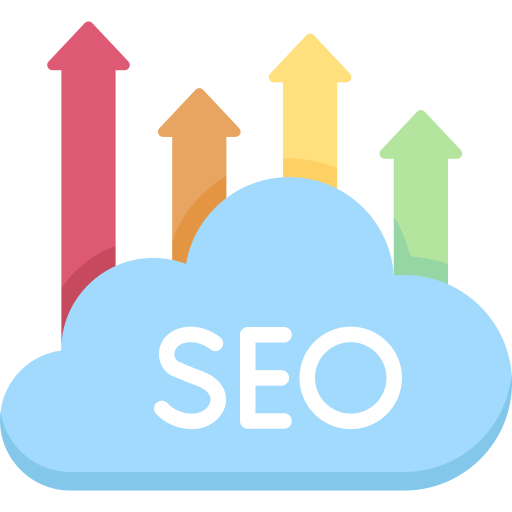
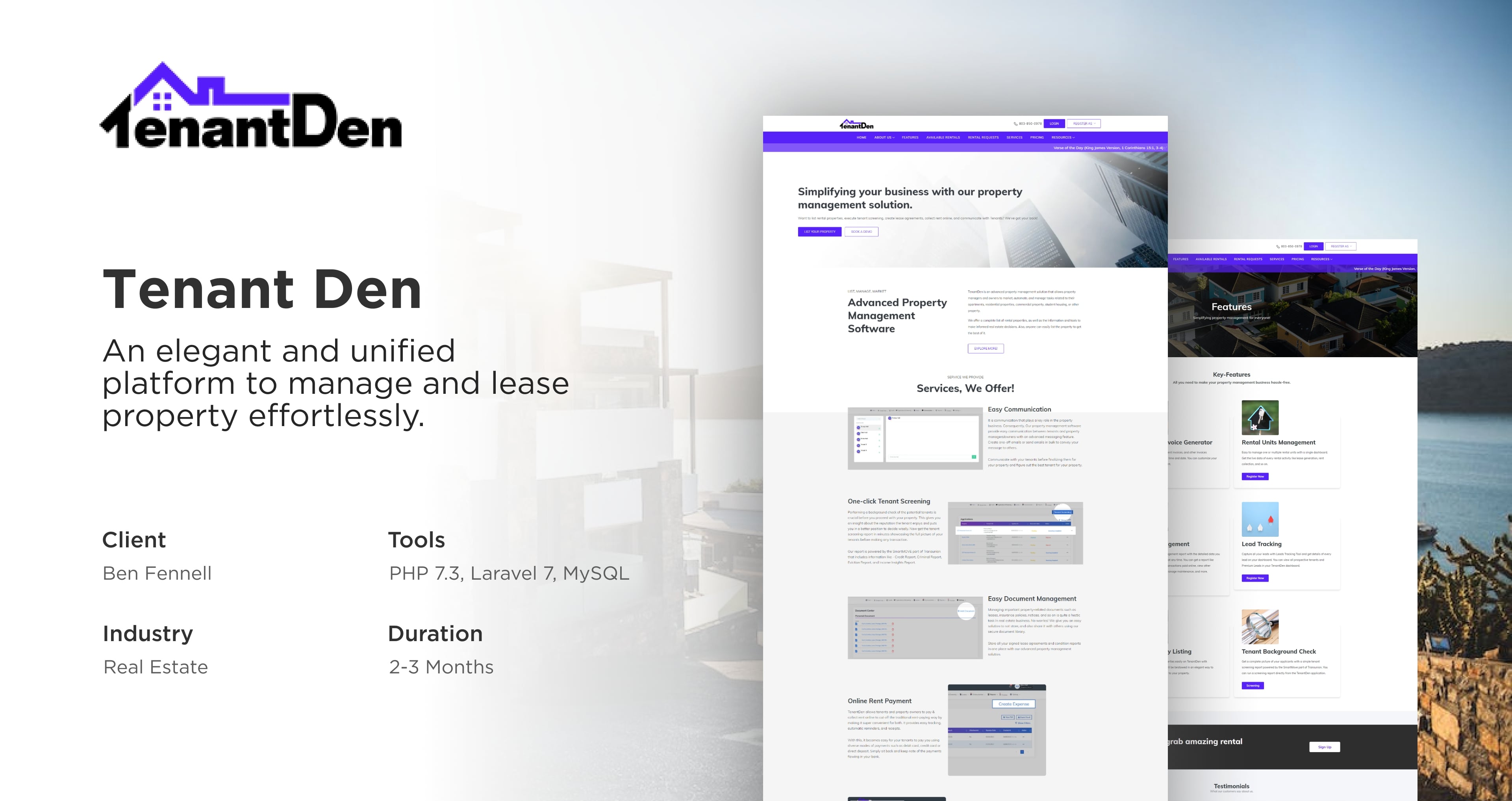

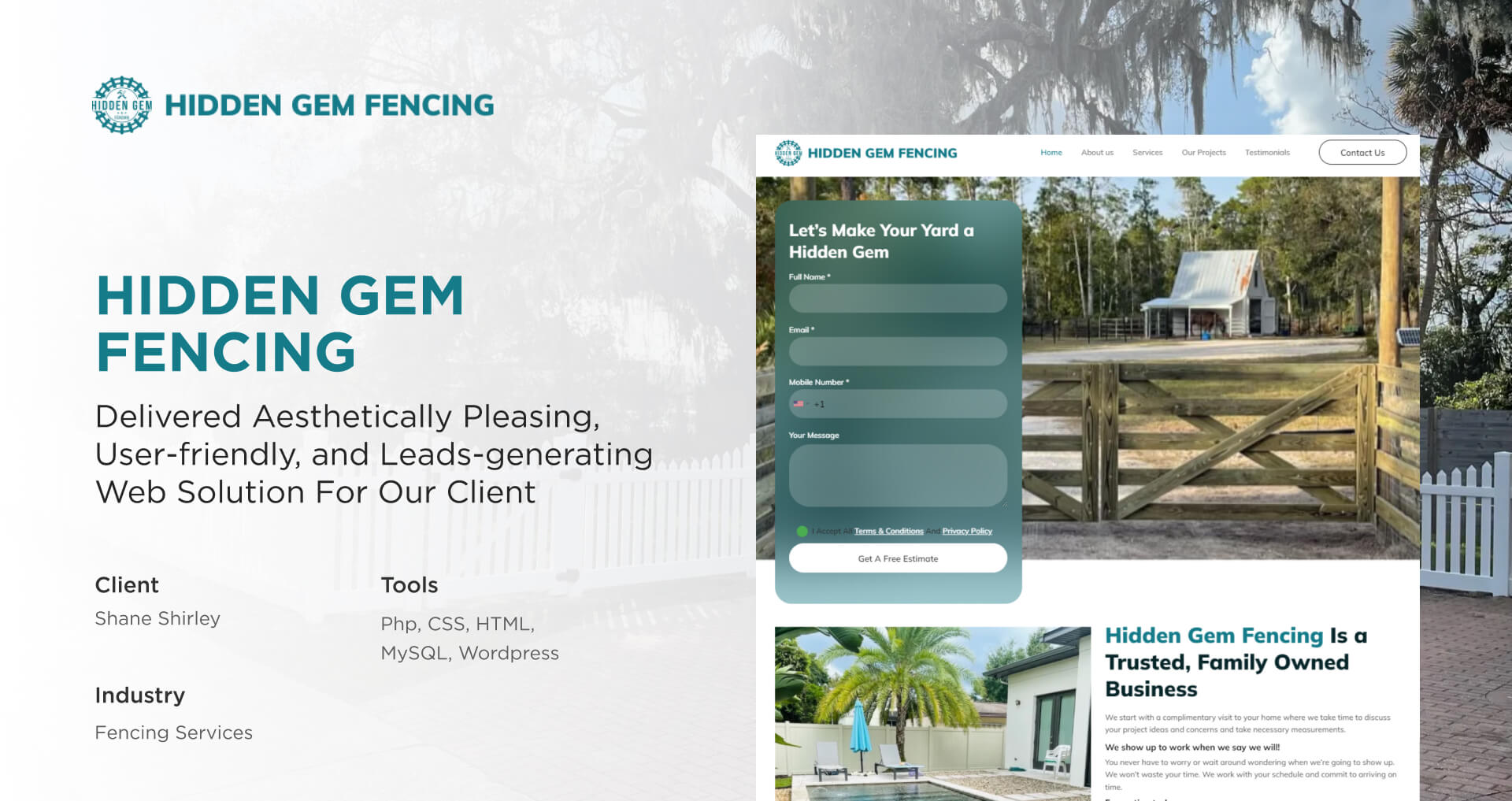

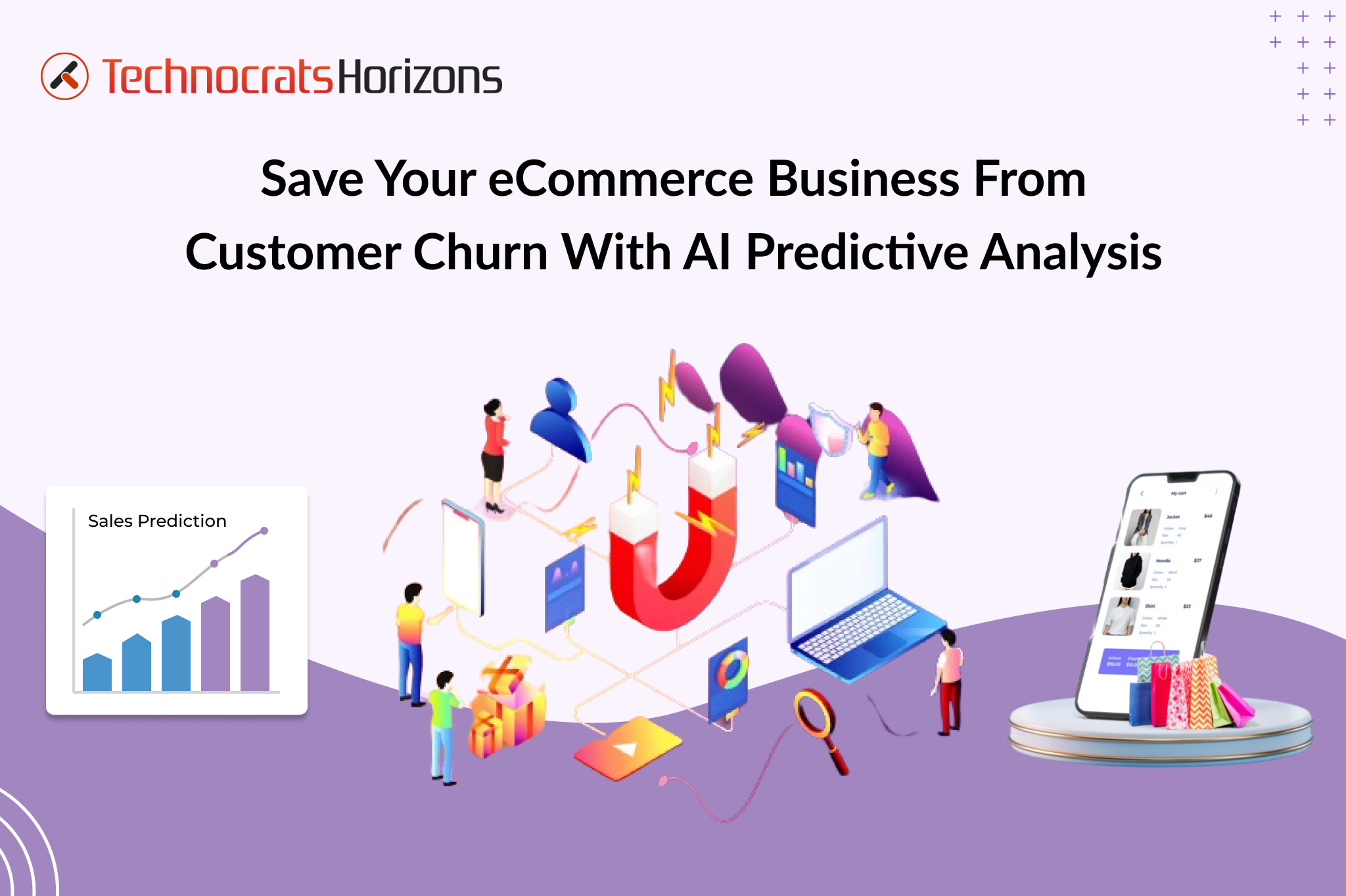


 Request a
Request a













